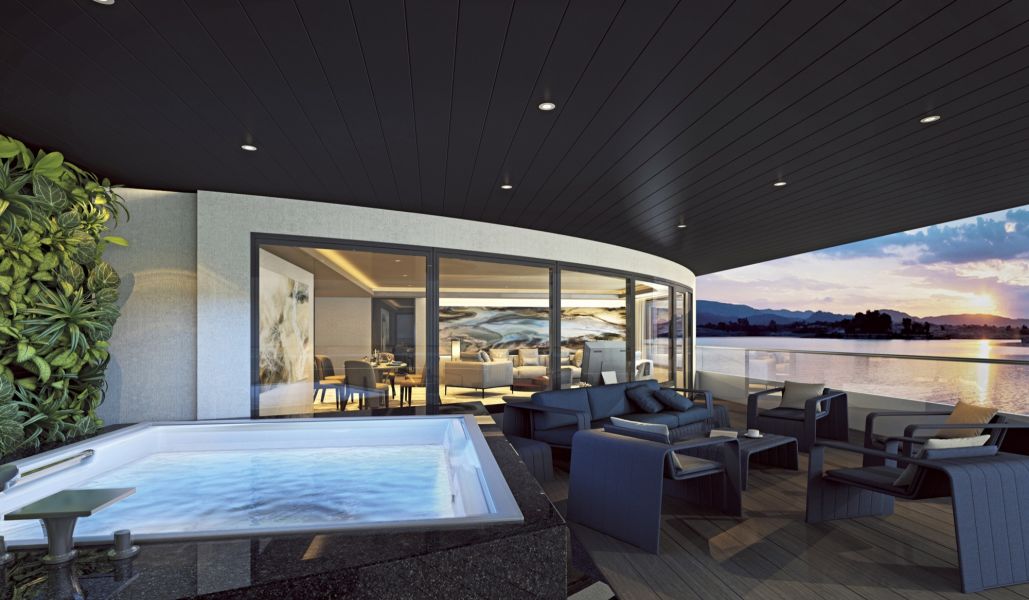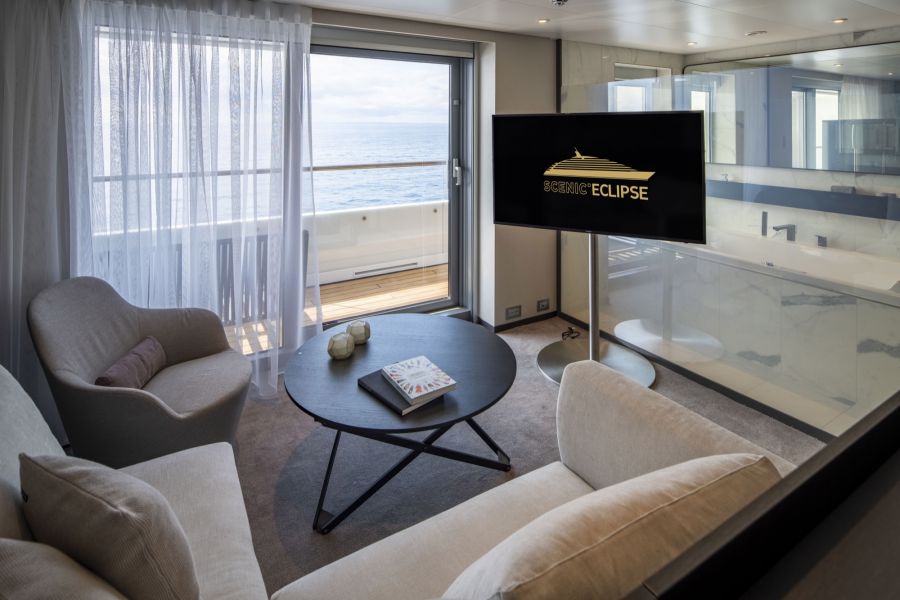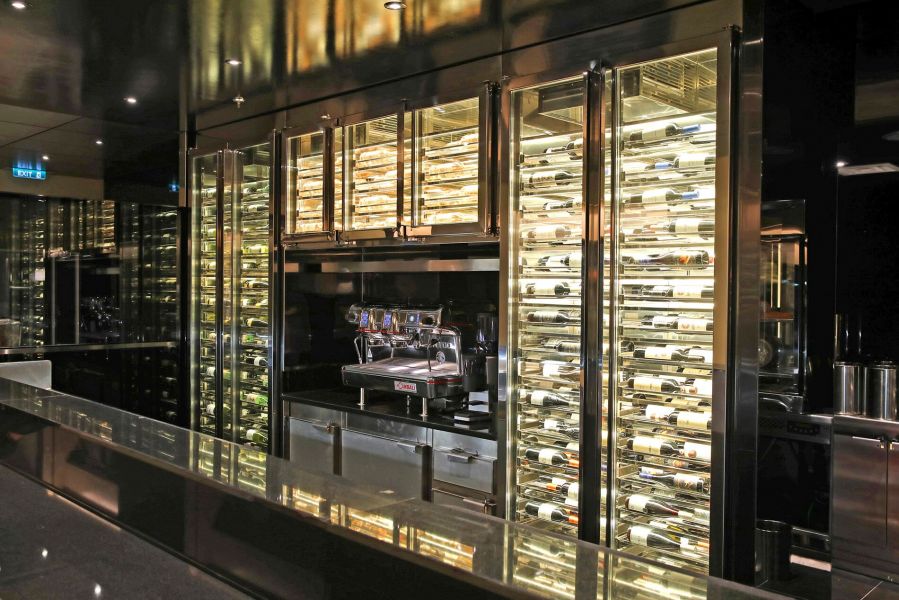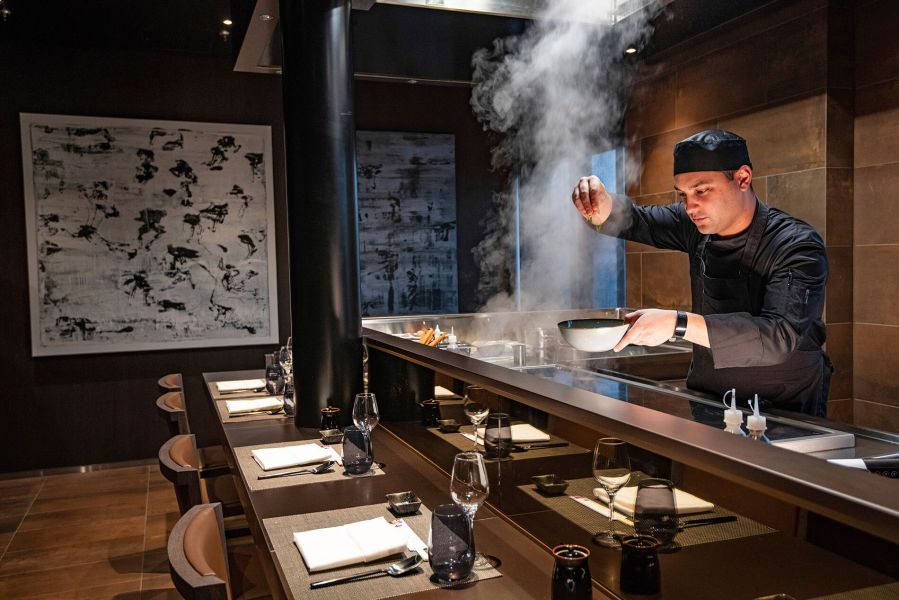This site uses cookies as defined in our Cookie Policy, by continuing to use this site you agree to their use.
Continue
| Arrive | Depart | ||||||
| 21st21 | AprApr | 202727 | Málaga, Spain, embark on the Scenic Eclipse | ||||
As you sail into Malaga you will notice what an idyllic setting the city enjoys on the famous Costa del Sol. To the east of this provincial capital, the coast along the region of La Axarqua is scattered with villages, farmland and sleepy fishing hamlets - the epitome of traditional rural Spain. To the west stretches a continuous city where the razzmatazz and bustle creates a colourful contrast that is easily recognisable as the Costa del Sol. Surrounding the region, the Penibéetica Mountains provide an attractive backdrop overlooking the lower terraced slopes which yield olives and almonds. This spectacular mountain chain shelters the province from cold northerly winds, giving it a reputation as a therapeutic and exotic place in which to escape from cold northern climes. Malaga is also the gateway to many of Andalusia's enchanting historic villages, towns and cities. Welcome to Spain’s famous Costa del Sol and the 3,000-year-old city of Malaga. Millions of visitors flock to the region for its namesake sunshine, rich history and artistic soul. Uncover culinary delights such as ‘tinto de verano’, a refreshing iced summer wine, and wander streets filled with architectural marvels. This afternoon, you’ll board your 6-star, ultra-luxury Discovery Yacht for your Signature Yacht Cruise. You will be shown to your spacious suite, where you can enjoy a drink on your private verandah and toast the start of this ultra-luxurious voyage. Please book your flight to arrive into Malaga prior to 02:00 PM. | |||||||
| 22nd22 | AprApr | 202727 | Almería, Spain | ||||
Immerse yourself in the rich history of Almería, where the majestic La Alcazaba fortress stands as a powerful symbol of Spain's Moorish heritage. Built in the mid-10th century, it was once one of the country's mightiest fortresses, second only to the iconic Alhambra. As your Discovery Yacht sails into port, enjoy the breathtaking coastal views before stepping ashore to explore Almería’s lively streets and historic treasures. With its perfect mix of culture, history, and stunning landscapes, Almería offers an unforgettable experience that will captivate you at every turn. | |||||||
| 23rd23 | AprApr | 202727 | Alicante, Spain | ||||
The provincial capital of the Valencian Community serves as a gateway to the huge influx of tourists that flock to the Costa Blanca resorts every year. Alicante is popular with holidaymakers who arrive for the warm, Mediterranean climate and seemingly endless golden beaches. However, there is much more to this city than sand and sun. With a picturesque waterfront, a hugely impressive castle, buzzing nightlife and a rich, complex history, Alicante is a fascinating destination all year round. Wake this morning in the city of Alicante, one of Spain’s most popular tourist destinations and unofficial capital of the Costa Blanca (White Coast). Alicante is built around the base of the imposing Moorish fortress of Castillo de Santa Barbara, dating back to the 9th century; climb the hill or take the elevator to explore. In El Barrio, the Old Town, soak up the sun with a walk along the beautiful, palm-tree lined Explanada de España. Make your reservation for the Night Market @ Koko’s (available by on board reservation), where chefs prepare unique dishes inspired by the street markets of Asia while you watch. | |||||||
| 24th24 | AprApr | 202727 | Barcelona, Spain | ||||
The infinite variety of street life, the nooks and crannies of the medieval Barri Gòtic, the ceramic tile and stained glass of Art Nouveau facades, the art and music, the throb of street life, the food (ah, the food!)—one way or another, Barcelona will find a way to get your full attention. The capital of Catalonia is a banquet for the senses, with its beguiling mix of ancient and modern architecture, tempting cafés and markets, and sun-drenched Mediterranean beaches. A stroll along La Rambla and through waterfront Barceloneta, as well as a tour of Gaudí's majestic Sagrada Famíliaand his other unique creations, are part of a visit to Spain's second-largest city. Modern art museums and chic shops call for attention, too. Barcelona's vibe stays lively well into the night, when you can linger over regional wine and cuisine at buzzing tapas bars. Discover the vibrant energy of Barcelona, a city where lively culture meets rich history and captivating outdoor spaces. Be inspired by Gaudí’s whimsical masterpieces and stroll along iconic boulevards like Las Ramblas, a mile-long, tree-lined promenade. From the enchanting city blocks to the awe-inspiring La Sagrada Família cathedral, Barcelona promises an unforgettable experience. | |||||||
| 25th25 | AprApr | 202727 | Barcelona, Spain | ||||
The infinite variety of street life, the nooks and crannies of the medieval Barri Gòtic, the ceramic tile and stained glass of Art Nouveau facades, the art and music, the throb of street life, the food (ah, the food!)—one way or another, Barcelona will find a way to get your full attention. The capital of Catalonia is a banquet for the senses, with its beguiling mix of ancient and modern architecture, tempting cafés and markets, and sun-drenched Mediterranean beaches. A stroll along La Rambla and through waterfront Barceloneta, as well as a tour of Gaudí's majestic Sagrada Famíliaand his other unique creations, are part of a visit to Spain's second-largest city. Modern art museums and chic shops call for attention, too. Barcelona's vibe stays lively well into the night, when you can linger over regional wine and cuisine at buzzing tapas bars. On your second day in Barcelona, explore the picturesque medieval lanes of the Gothic Quarter, the city's oldest district, where traces of the ancient Roman wall have been uncovered. Among its many treasures is the stunning neo-Gothic Barcelona Cathedral, a true masterpiece of architecture. Alternatively, immerse yourself in one of the Scenic Freechoice experiences, offering a unique way to discover the beauty and charm of Barcelona. | |||||||
| 26th26 | AprApr | 202727 | Marseille, France | ||||
Since being designated a European Capital of Culture for 2013, with an estimated €660 million of funding in the bargain, Marseille has been in the throes of an extraordinary transformation, with no fewer than five major new arts centers, a beautifully refurbished port, revitalized neighborhoods, and a slew of new shops and restaurants. Once the underdog, this time-burnished city is now welcoming an influx of weekend tourists who have colonized entire neighborhoods and transformed them into elegant pieds-à-terre (or should we say, mer). The second-largest city in France, Marseille is one of Europe's most vibrant destinations. Feisty and fond of broad gestures, it is also as complicated and as cosmopolitan now as it was when a band of Phoenician Greeks first sailed into the harbor that is today's Vieux Port in 600 BC. Legend has it that on that same day a local chieftain's daughter, Gyptis, needed to choose a husband, and her wandering eyes settled on the Greeks' handsome commander Protis. Her dowry brought land near the mouth of the Rhône, where the Greeks founded Massalia, the most important Continental shipping port in antiquity. The port flourished for some 500 years as a typical Greek city, enjoying the full flush of classical culture, its gods, its democratic political system, its sports and theater, and its naval prowess. Caesar changed all that, besieging the city in 49 BC and seizing most of its colonies. In 1214 Marseille was seized again, this time by Charles d'Anjou, and was later annexed to France by Henri IV in 1481, but it was not until Louis XIV took the throne that the biggest transformations of the port began; he pulled down the city walls in 1666 and expanded the port to the Rive Neuve (New Riverbank). The city was devastated by plague in 1720, losing more than half its population. By the time of the Revolution, Marseille was on the rebound once again, with industries of soap manufacturing and oil processing flourishing, encouraging a wave of immigration from Provence and Italy. With the opening of the Suez Canal in 1869, Marseille became the greatest boomtown in 19th-century Europe. With a large influx of immigrants from areas as exotic as Tangiers, the city quickly acquired the multicultural population it maintains to this day. The oldest city in France, Marseille dates to 600BC. Today, it’s a fast-paced, modern city brimming with multicultural flavours, and flanked by breathtaking natural scenery and golden beaches. This is a place where grit and grandeur meet, offering a fascinating insight into contemporary French culture. Explore its ancient streets and diverse neighbourhoods, marvel at iconic landmarks such as the Basilique Notre-Dame de la Garde and treat yourself to the freshest seafood and traditional delicacies. Marseille is also the gateway to the region of Provence, famous for its wine and cuisine. | |||||||
| 27th27 | AprApr | 202727 | Saint-Tropez, France | ||||
At first glance, it really doesn't look all that impressive. There's a pretty port with cafés charging €5 for a coffee and a picturesque old town in sugared-almond hues, but there are many prettier in the hills nearby. There are sandy beaches, rare enough on the Riviera, and old-fashioned squares with plane trees and pétanque players, but these are a dime a dozen throughout Provence. So what made St-Tropez an internationally known locale? Two words: Brigitte Bardot. When this pulpeuse (voluptuous) teenager showed up in St-Tropez on the arm of Roger Vadim in 1956 to film And God Created Woman, the heads of the world snapped around. Neither the gentle descriptions of writer Guy de Maupassant (1850–93), nor the watercolor tones of Impressionist Paul Signac (1863–1935), nor the stream of painters who followed (including Matisse and Bonnard) could focus the world's attention on this seaside hamlet as did this one sensual woman in a scarf, Ray-Bans, and capris. Vanity Fair ran a big article, "Saint Tropez Babylon," detailing the over-the-top petrodollar parties, megayachts, and Beyoncé–d paparazzi. But don't be turned off: the next year, Stewart, Tabori & Chang released an elegant coffee-table book, Houses of St-Tropez, packed with photos of supremely tasteful and pretty residences, many occupied by fashion designers, artists, and writers. Once a hangout for Colette, Anaïs Nin, and Françoise Sagan, the town still earns its old moniker, the "Montparnasse of the Mediterranean." Yet you might be surprised to find that this byword for billionaires is so small and insulated. The lack of train service, casinos, and chain hotels keeps it that way. Yet fame, in a sense, came too fast for St-Trop. Unlike the chic resorts farther east, it didn't have the decades-old reputation of the sort that would attract visitors all year around. For a good reason: its location on the south side of the gulf puts it at the mercy of the terrible mistral winter winds. So, in summer the crowds descend and the prices rise into the stratosphere. In July and August, you must be carefree about the sordid matter of cash. After all, at the most Dionysian nightclub in town, a glass of tap water goes for $37 and when the mojo really gets going, billionaires think nothing of "champagne-spraying" the partying crowds—think World Series celebrations but with $1,000 bottles of Roederer Cristal instead of Gatorade. Complaining about summer crowds, overpricing, and lack of customer service has become a tourist sport and yet this is what makes St-Tropez—described by the French daily newspaper Le Figaro as the place you can see "the greatest number of faces per square meter"—as intriguing as it is seductive. Saint-Tropez, once a quiet fishing village, became a glamorous travel destination in the 1950s, thanks to Brigitte Bardot and the film And God Created Woman. Today, it still retains all the glitz and glamour, alongside glittering blue seas, stunning beaches and a bohemian art scene. Stroll along the cobblestone streets of the old fishing quarter of La Ponche, and revel in the abstract architecture and sunlit landscapes that inspired great artists and filmmakers. With a late departure, see Saint-Tropez come alive after dark. | |||||||
| 28th28 | AprApr | 202727 | Monte-Carlo, Monaco | ||||
On one of the best stretches of the Mediterranean, this classic luxury destination is one of the most sought-after addresses in the world. With all the high-rise towers you have to look hard to find the Belle Époque grace of yesteryear. But if you head to the town's great 1864 landmark Hôtel de Paris—still a veritable crossroads of the buffed and befurred Euro-gentry—or enjoy a grand bouffe at its famous Louis XV restaurant, or attend the opera, or visit the ballrooms of the casino, you may still be able to conjure up Monaco's elegant past. Prince Albert II, a political science graduate from Amherst College, traces his ancestry to Otto Canella, who was born in 1070. The Grimaldi dynasty began with Otto's great-great-great-grandson, Francesco Grimaldi, also known as Frank the Rogue. Expelled from Genoa, Frank and his cronies disguised themselves as monks and in 1297 seized the fortified medieval town known today as Le Rocher (the Rock). Except for a short break under Napoléon, the Grimaldis have been here ever since, which makes them the oldest reigning family in Europe. In the 1850s a Grimaldi named Charles III made a decision that turned the Rock into a giant blue chip. Needing revenue but not wanting to impose additional taxes on his subjects, he contracted with a company to open a gambling facility. The first spin of the roulette wheel was on December 14, 1856. There was no easy way to reach Monaco then—no carriage roads or railroads—so no one came. Between March 15 and March 20, 1857, one person entered the casino—and won two francs. In 1868, however, the railroad reached Monaco, and it was filled with Englishmen who came to escape the London fog. The effects were immediate. Profits were so great that Charles eventually abolished all direct taxes. Almost overnight, a threadbare principality became an elegant watering hole for European society. Dukes (and their mistresses) and duchesses (and their gigolos) danced and dined their way through a world of spinning roulette wheels and bubbling champagne—preening themselves for nights at the opera, where such artists as Vaslav Nijinsky, Sarah Bernhardt, and Enrico Caruso came to perform. Along with the tax system, its sensational position on a broad, steep peninsula that bulges into the Mediterranean—its harbor sparkling with luxury cruisers, its posh mansions angling awnings toward the nearly perpetual sun—continues to draw the rich and famous. One of the latest French celebrities to declare himself "Monégasque," thus giving up his French passport, is superchef Alain Ducasse, who said that he made the choice out of affection for Monaco rather than tax reasons. Pleasure boats vie with luxury cruisers in their brash beauty and Titanic scale, and teams of handsome young men—themselves dyed blond and tanned to match—scour and polish every gleaming surface. As you might expect, all this glitz doesn't come cheap. Eating is expensive, and even the most modest hotels cost more here than in nearby Nice or Menton. As for taxis, they don't even have meters so you are completely at the driver's mercy (with prices skyrocketing during events such as the Grand Prix). For the frugal, Monaco is the ultimate day-trip, although parking is as coveted as a room with a view. At the very least you can afford a coffee at Starbucks. The harbor district, known as La Condamine, connects the new quarter, officially known as Monte Carlo with Monaco-Ville (or Le Rocher), a medieval town on the Rock, topped by the palace, the cathedral, and the Oceanography Museum. Have no fear that you'll need to climb countless steps to get to Monaco-Ville, as there are plenty of elevators and escalators climbing the steep cliffs. But shuttling between the lovely casino grounds of Monte Carlo and Old Monaco, separated by a vast port, is a daunting proposition for ordinary mortals without wings, so hop on the No. 1 bus from Saint Roman, or No. 2 from the Jardin Exotique - Both stop at Place du Casino and come up to Monaco Ville. Monte Carlo is the ultimate playground for the elite, a haven of sleek superyachts and chic sophistication. From the enchanting streets of Monaco’s Old Town to the legendary Place du Casino, designed by the iconic Charles Garnier, every moment exudes allure. As the world’s second smallest country, Monaco proves that size doesn’t matter when you’re dripping in elegance, brimming with glamour, and radiating opulence. Indulge in the lifestyle of the extraordinary, because in Monaco, every day is a masterpiece. | |||||||
| 29th29 | AprApr | 202727 | Cannes, France | ||||
Cannes is pampered with the luxurious year-round climate that has made it one of the most popular resorts in Europe. Cannes was an important sentinel site for the monks who established themselves on Île St-Honorat in the Middle Ages. Its bay served as nothing more than a fishing port until in 1834 an English aristocrat, Lord Brougham, fell in love with the site during an emergency stopover with a sick daughter. He had a home built here and returned every winter for a sun cure—a ritual quickly picked up by his peers. Between the popularity of Le Train Blue transporting wealthy passengers from Calais, and the introduction in 1936 of France's first paid holidays, Cannes became the destination, a tasteful and expensive breeding ground for the upper-upscale.Cannes has been further glamorized by the ongoing success of its annual film festival, as famous as Hollywood's Academy Awards. About the closest many of us will get to feeling like a film star is a stroll here along La Croisette, the iconic promenade that gracefully curves the wave-washed sand coastline, peppered with chic restaurants and prestigious private beaches. This is precisely the sort of place for which the French invented the verb flâner (to dawdle, saunter): strewn with palm trees and poseurs, its fancy boutiques and status-symbol grand hotels—including the Carlton, the legendary backdrop to Grace Kelly in To Catch a Thief —all vying for the custom of the Louis Vuitton set. This legend is, to many, the heart and soul of the Côte d'Azur. Welcome to Cannes, the world’s cinematic capital where glamour meets the sea. Stroll along the iconic La Croisette, shop haute couture boutiques, or unwind on sun-drenched beaches. Take in breathtaking views from castle ruins, marvel at luxury yachts, and sip cocktails at chic beach bars. There’s plenty of history and culture to be found in this coastal enclave, but it’s really a place to relax and soak up the champagne lifestyle that plays out alongside the sparkling Mediterranean every day. | |||||||
| 30th30 | AprApr | 202727 | Portovenere, Italy | ||||
The colorful facades and pedestrians-only calata (promenade) make Portovenere the quintessential Ligurian seaside village. As a UNESCO World Heritage Site, its harbor is lined with tall, thin "terratetto" houses that date from as far back as the 11th century and are connected in a wall-like formation to protect against attacks by the Pisans and local pirates. Its tiny, carruggi (alley-like passageways) lead to an array of charming shops, homes, and gardens and eventually to the village's impressive Castle Doria high on the olive tree covered hill. To the west standing guard over the Mediterranean is the picturesque medieval Chiesa di San Pietro, once the site of a temple to Venus (Venere in Italian), from which Portovenere gets its name. Nearby, in a rocky area leading to the sea, is Byron's Cave, a favorite spot that the poet loved to swim out into the sea from. Dubbed the “sixth” Cinque Terre town, Porto Venere is a UNESCO World Heritage-listed site that has extraordinary rocky coastlines, narrows streets winding through a medieval town, and sweeping Mediterranean views. Porto Venere is a hidden gem that is less frequented, allowing you the space to relax and experience the town for all that it is. Previously used as a Roman naval station, there is a lot of history for you to explore along this jagged coastline. Popular poets and writers such as Byron, Shelley and Lawrence are known to have fallen in love with the picturesque harbour. | |||||||
| 1st01 | MayMay | 202727 | Carrara, Italy | ||||
Marina di Carrara sits on the coast, tucked between sandy beaches and forested mountains. Many of Italy’s most famous works of art, including Michelangelo’s David, began their life in these mountains. Look closely – that’s not snow on the Apuan Alps, but world-famous Carrara marble. Today, set up beneath a striped umbrella at one of the many beach clubs. Or take a shuttle into Carrara town, where everything from fountains to cathedrals are made from their signature stone. With an overnight, make the most of the town’s western aspect and watch the sun sink over the water from your private verandah. | |||||||
| 2nd02 | MayMay | 202727 | Livorno, Italy | ||||
Livorno is a gritty city with a long and interesting history. In the early Middle Ages it alternately belonged to Pisa and Genoa. In 1421 Florence, seeking access to the sea, bought it. Cosimo I (1519–74) started construction of the harbor in 1571, putting Livorno on the map. After Ferdinando I de' Medici (1549–1609) proclaimed Livorno a free city, it became a haven for people suffering from religious persecution; Roman Catholics from England and Jews and Moors from Spain and Portugal, among others, settled here. The Quattro Mori (Four Moors), also known as the Monument to Ferdinando I, commemorates this. (The statue of Ferdinando I dates from 1595, the bronze Moors by Pietro Tacca from the 1620s.)In the following centuries, and particularly in the 18th, Livorno boomed as a port. In the 19th century the town drew a host of famous Britons passing through on their grand tours. Its prominence continued up to World War II, when it was heavily bombed. Much of the town's architecture, therefore, postdates the war, and it's somewhat difficult to imagine what it might have looked like before. Livorno has recovered from the war, however, as it's become a huge point of departure for container ships, as well as the only spot in Tuscany for cruise ships to dock for the day.Most of Livorno's artistic treasures date from the 17th century and aren't all that interesting unless you dote on obscure baroque artists. Livorno's most famous native artist, Amedeo Modigliani (1884–1920), was of much more recent vintage. Sadly, there's no notable work by him in his hometown.There may not be much in the way of art, but it's still worth strolling around the city. The Mercato Nuovo, which has been around since 1894, sells all sorts of fruits, vegetables, grains, meat, and fish. Outdoor markets nearby are also chock-full of local color. The presence of Camp Darby, an American military base just outside town, accounts for the availability of many American products.If you have time, Livorno is worth a stop for lunch or dinner at the very least. The vibrant city of Livorno has been welcoming sailors and traders from around the globe for over 400 years. As one of Italy's most cosmopolitan cities, Livorno serves as the gateway to the magnificent Tuscany region, renowned for its picturesque landscapes, delectable cuisine, and rich artistic heritage. Located conveniently close to Florence and Pisa, Livorno offers easy access to these iconic destinations. Explore the enchanting 17th century district of Venezia Nuova, delight your senses at the bustling Central Market or wander along the grand Terrazza Magascani overlooking the waterfront. | |||||||
| 3rd03 | MayMay | 202727 | Bastia, France | ||||
Corsica's northern capital, Bastia, is the centre of commerce and industry and a thriving freight and passenger port. Commerce, more than tourism, is its main focus, providing employment for many Corsicans. Bastia's industrial sprawl, however, is offset by its aged charm. The presence of an overwhelming Italian atmosphere adds to the city's attraction. Two distinct areas comprise the city: Terra Vecchia, the old quarter, consisting of haphazard streets, flamboyant Baroque churches and lofty tenements, with their crumbling golden-grey walls set against a backdrop of fire-darkened hills; and the more orderly Terra Nova, the historic district favoured by prominent doctors, lawyers and architects. The city dates from Roman times, when a base was set up at Biguglia to the south. Under the Genoese, Bastia was the island's capital for four centuries and of major importance for the export of wine to the Italian mainland. They built a fortress (bastiglia), which gave the town its name. The Genoese also were responsible for laying the foundation for the area's prosperity by planting vines, olives, chestnut trees and other experimental crops. This resulted in an energetic and enterprising region, still a characteristic of today's northern Corsica. Although Napoleon had appointed Ajaccio the capital of the island in 1811- initiating a rivalry that still exists - Bastia established a stronger trading position with mainland France. As a result, the Nouveau Port was created in 1862 to cope with the increasing traffic with France and Italy. Bastia's economic prominence and a German division based here during World War II accounted for severe bombing attacks. Many buildings were destroyed, including much of the old governor's palace. Of the two largest towns on the island, Ajaccio and Bastia, the latter boasts a more genuine Corsican character. Visitors can experience an authentic feel of island life by wandering through the maze of narrow streets of Bastia's old quarter and by exploring its fortifications. Don't miss the vast Place Saint-Nicolas just north of the old quarter; it is the focal point of the city. Open to the sea and lined with shady trees and sidewalk cafes, it is a perfect place for people watching and for taking in the local ambiance. Pier Information The ship is scheduled to dock at the port of Bastia. The city's focal point, Place Saint-Nicolas, is a distance of 650 feet (200 metres) to walk. Taxis are generally available at the pier but it is highly recommended to book in advance if you want to be sure to get one. It is recommended to establish the fare before leaving the port. Shopping The main shopping streets, Boulevard Paoli and Rue Cesar Campinchi, are less than one half miles (500 metres) from the port terminal. Handicrafts and the area's specialties such as honey, wine and liqueurs may be of interest. Most shops are open from 9:00 a.m. to 12:00 p.m. and 2:30 p.m. to 7:00 p.m. Shops are closed for the day on Sundays and some shops may also close Monday mornings (some souvenirs shops may open Sundays during the high season of July-August). The local currency is the euro. Cuisine A variety of restaurants offer a good choice of eating possibilities. Some of the best restaurants are found around the Vieux Port and on the Quai des Martyrs. French cuisine and seafood feature prominently on menus as well as such Corsican specialties as wild boar, charcuterie and aziminu, a local version of bouillabaisse. Evidence of Bastia's strong Italian influence is apparent in the numerous pizza and pasta places in the Nouveau Port area. For outdoor dining and people watching, cafes around lively Place Saint-Nicolas are a perfect place. Other Sites Oratoire de Saint-Roch Located in the Terra Vecchia quarter, the chapel is a Genoese Baroque extravaganza built in 1604. The walls are covered with finely carved wooden panelling and the organ is magnificent with its decoration of gilt and wooden sculpture. Oratoire de L'Immaculee Conception Although its exterior is rather austere, the flamboyant interior of this 17th-century church with gilt and marble ceiling, frescoes and crystal chandeliers creates an ambiance of an opera house. Vieux Port Site of the original Porto Prado, the area around the Vieux Port is the most appealing part of town. Its soaring houses seem to bend inwards towards the water. Once busy with Genoese traders, the building of the ferry terminal and commercial docks have reduced much of the action at Vieux Port. Terra Nova As the administrative core of old Bastia, Terra Nova displays a distinct air of affluence. Its most impressive building is the 14th-century Governor's Palace. During the Genoese heyday the governor and the bishop lived here, entertaining foreign dignitaries and hosting massive parties. Private arrangements for independent sightseeing may be requested through the Tour Office on board, subject to the availability of English-speaking guides. France’s second busiest cruise port (after Calais) and one of the busiest in the Mediterranean, Bastia is the gateway to the island of Corsica. The old town is split into two parts; Terra Vecchia around the harbour and Terra Nova in the high-walled citadel above. The narrow laneways are lined with a number of impressive churches, grand public buildings and charmingly jumbled apartment buildings. Place Saint-Nicolas is at the heart of the town, a charming square lined with outdoor cafes. Watch the world go by with a coffee or glass of wine. | |||||||
| 4th04 | MayMay | 202727 | Porto Santo Stefano, Italy | ||||
Discover Porto Santo Stefano, a coastal paradise on the Tuscan Riviera where history meets Mediterranean beauty. Wander through its charming streets, uncover the 16th-century Spanish Fortress, and soak in the vibrant harbour views. Delight in exquisite fresh seafood, paired with local wines and olive oils, at seaside eateries. With a late departure, don't miss the mesmerising sunset—an enchanting end to your perfect day. | |||||||
| 5th05 | MayMay | 202727 | Civitavecchia, Italy, disembark the Scenic Eclipse | ||||
Italy's vibrant capital lives in the present, but no other city on earth evokes its past so powerfully. For over 2,500 years, emperors, popes, artists, and common citizens have left their mark here. Archaeological remains from ancient Rome, art-stuffed churches, and the treasures of Vatican City vie for your attention, but Rome is also a wonderful place to practice the Italian-perfected il dolce far niente, the sweet art of idleness. Your most memorable experiences may include sitting at a caffè in the Campo de' Fiori or strolling in a beguiling piazza. This morning, you will arrive in Civitavecchia, the gateway to Rome, where ancient history and modern charm intertwine. After a final delicious breakfast, bid farewell to your dedicated crew, taking with you memories of an unforgettable voyage. If you’re not ready for your journey to end, consider joining our post-cruise land tour from Rome to Venice—an incredible opportunity to explore Italy’s most iconic cities, breathtaking landscapes, and rich cultural treasures. Enquire today for more details on this exclusive experience. Please book your flight to depart out of Rome after 12:00 PM. #Senses Spa treatments and services at additional cost. Daily activities may be subject to change; please consult your Daily Wonder for updates. +All drinks on board, including those stocked in your mini bar, are included, except for a very small number of rare, fine and vintage wines, Champagnes and spirits. Specialty restaurants require a reservation, enquire on board. ^Flights on board our two helicopters and submersible experiences are at additional cost, subject to regulatory approval, availability, weight restrictions, medical approval and weather conditions. Helicopter not operational in France. Submersible not operational in Europe. The itinerary is a guide only and may be amended for operational reasons. As such Scenic cannot guarantee the voyage will operate unaltered from the itinerary stated above. Please refer to our terms and conditions for further information. | |||||||









The images shown are for illustration purposes only and may not be an exact representation of what you find on the ship.

Every feature of these spacious suites has been carefully considered to create the ultimate retreat. From the unsurpassed views, no matter where you are, to a private lounge and dining area, a super-sized bathroom and your butler unpacking your bags on arrival, you’ll never want to leave.
For a once-in-a-lifetime cruising experience, combine one of the Owner’s Penthouse Suites with a Spa Suite to create the lavish Two-Bedroom Penthouse Suite –an incredible 245m2, of unsurpassed luxury and opulence.
Handcrafted, sumptuous and extraordinary in every regard, staying in one of only two Owner’s Penthouse Suites is the ultimate indulgence. Your home away from home is located at the bow of the yacht, on Deck 9, and boasts the best views on board.
Featuring a spacious curved terrace with personal private spa pool and sun loungers, a private lounge and dining area and a super-sized bathroom, these 195m2 over-sized suites set the benchmark in ultra-luxury accommodation at sea, thanks to the extra special touches for which Scenic are famous.
At an enormous 195m2 in size, located on Deck 9 with all the inclusions of our Panorama Suites plus:
Some measurements are approximate, and those in same category may vary in size.

Imagine returning from an exhilarating day of truly all-inclusive discovery excursions to your private sanctuary of your Spa Suite, with a steaming bath drawn by your butler. Gaze out over your verandah to the vistas beyond and sip on a glass of champagne – heaven.
With a premier location on the higher Decks 8 and 9 and an impressive 46-50m2 in size, our opulent Spa Suites provide the most inviting of luxury retreats. Featuring a four-poster king-size Scenic Slumber Bed, separate living room as well as a private verandah, they are the perfect retreat after a day of discovery.
The signature double size Philippe Starck-designed spa bath overlooking your verandah is exclusive to these suites, providing the perfect complement to your days of activities.
You’ll also be pampered with a complementary spa treatment during your cruise.
Ranging in size from 46-50m2, located on Deck 8 and 9 with all the inclusions of our Verandah Suites plus:
The images shown are for illustration purposes only and may not be an exact representation of what you find on the ship.

Main restaurant featuring Italian, steak and seafood from an a la carte dinner menu.
Elements restaurant, located on Deck 4, offers guests a more relaxed dining experience during either breakfast, lunch or dinner, with seating for up to 104 guests.
Be greeted by your Scenic hostess as you enter and are escorted to your table. Reservations are not required to dine at Elements, with a flexible array of seating options for you to dine alone or with new friends on larger tables where you can share your experiences from your daily discoveries.
Enjoy premium beverages from Elements bar which has a selection of fine wines, a classic beverage program and a broad menu of international cheeses.

A comprehensive 24-hour menu
When the mood strikes to dine in the privacy of your suite, your butler can arrange everything. Choose from the 24-hour in-suite dining menu and your cuisine and accompanying premium beverages will be delivered and served for you to savour in the solitude of your suite.
Your butler will also ensure that your in-suite mini-bar is re-stocked daily in accordance with your favourite premium beverages. You might like to start your day with a cup of aromatic illy coffee made from your in-suite Espresso coffee machine, or sip on a specialty tea in the sunlight on your verandah.

Private dining with an authentic Teppanyaki grill
Night Market @ Koko’s features a classic teppanyaki grill. Enjoy real interaction with the chef as he guides you on an inspired journey of the night market dishes from Asia, India and the Middle East, preparing dishes right in front of you. This experience is not the usual show you may envisage, where food is thrown and eggs cracked on the grill. Rather, it is an intimate dining experience for only eight guests and the chef. There are waiters continuously circulating with beverages and making sure the guests are well attended. Bookings are required for the Night Market @ Koko’s dining, located on Deck 4.

Yacht Club grill restaurant and bar, serving breakfast and lunch
The Yacht Club on Deck 7 has recently been significantly reimagined to create a more casual and flexible dining experience. The venue has been redesigned to include new food islands and enhanced outdoor and lounge seating to create a casual ambience.
“We have a new large sofa lounge to give guests the option of eating in a more casual way than on traditional dining tables. We added a big gelato cooler which will showcase our freshly-made gelato at its finest. Overall, I’m very excited about the new Yacht Club. I imagine it will be a space where guests will mingle, dine or simply ‘hang out’ in one of our brand-new swing chairs and enjoy the magnificent views,” said Chef Tom.
The images shown are for illustration purposes only and may not be an exact representation of what you find on the ship.
The images shown are for illustration purposes only and may not be an exact representation of what you find on the ship.
The images shown are for illustration purposes only and may not be an exact representation of what you find on the ship.
| Return flights including luggage allowance | |||
| Overseas Transfers | |||
| 14 nights aboard the Scenic Eclipse | |||
| Return Flights (including regional) | |||
| All Verandah Suites | |||
| Butler service for every guest | |||
| Nine Dining Venues | |||
| Gratuities Included | |||
| Complimentary drinks on-board | |||
| Free use of electric bikes | |||
| Comprehensive choice of shore excursions | |||
| Complimentary Wi-Fi | |||
| Explore under the sea in our submarine (additional charge) | |||
| Soar above and beyond by helicopter (additional charge) | |||
| Port Taxes and Fees | |||
 | ABTA and ATOL Protection* | ||
Fly/cruise package |
Date 21st Apr 2027 |
Nts 14 |
Interior  |
Oceanview  |
Balcony  |
Suite £15,024pp |
Interior  |
Oceanview  |
Balcony  |
Suite £30,048pp |
Date 21st Apr 2027 |
Nts 14 |
Interior  |
Oceanview  |
Balcony  |
Suite £15,024pp |
Interior  |
Oceanview  |
Balcony  |
Suite £30,048pp |






Fusion Cruises when selling travel arrangements is a trading name of The Midcounties Co-operative Ltd. Fusion Cruises is an Accredited Body Member of Midcounties Co-operative Travel Consortium. (ABTA:P6652, ATOL:6053).
Book with Confidence. We are a Member of ABTA which means you have the benefit of ABTA’s assistance and Code of Conduct.
Some of the flights and flight-inclusive holidays on this website are financially protected by the ATOL scheme but ATOL protection does not apply to all holiday and travel services offered on this website. This website will provide you with information on the protection that applies in the case of each holiday and travel service offered before you make your booking. If you do not receive an ATOL Certificate then the booking will not be ATOL protected. If you do receive an ATOL Certificate but all parts of your trip are not listed on it, those parts will not be ATOL protected. Please see our booking conditions for information, or for more information about financial protection and the ATOL Certificate go to: www.caa.co.uk
